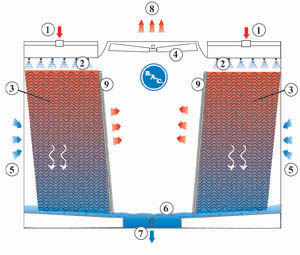Cooling a fluid or condensing a gas via evaporative cooling is all-natural, using water as the cooling medium and efficiently dissipating heat into the sky.
Principle of operation
The cooling process is achieved via close water/air contact, and transfer of heat to the air by small scale water evaporation. The heat is then dissipated via the warm, saturated discharge air.
Legend:
- Hot water in
- Water spray distribution system
- Heat transfer media
- Fan system
- Ambient air in
- Water collection basin
- Cold water out
- Warm saturated air out
- Drift eliminators
Advantages
- Lower cooling water temperatures: The amount of evaporation – and hence heat transfer – depends on the wet bulb temperature of the ambient air which, in summer especially, is far lower than the equivalent dry bulb temperature. For example, during hot summer days with dry bulb temperatures exceeding 40°C, evaporative cooling can cool water down as far as 25°C.
- Because evaporation removes more heat than by standard sensible heat transfer, four times less airflow is used compared to conventional air-cooled methods for heat transfer, saving considerable energy.
Evaporative cooling products
Various types of evaporative cooling products exist, all featuring:
- a heat exchange or transfer section made constantly wetted via a water spray arrangement,
- a fan system to force or induce ambient air via the heat exchange section
- other auxiliary components such as a water collection sump, drift eliminators and controls.
BAC offers the following evaporative cooling technology products:
- open cooling towers
- closed circuit cooling towers or coolers
- condensers
- dry coolers with adiabatic pre-coolers (common known as adiabatic coolers)
Evaporative cooling equipment is marketed in a range of sizes, from compact units that are transportable fully assembled up to huge units requiring on-site construction or assembly.
A choice of many construction materials and fan arrangements allow the designer to optimally combine performance, energy usage and service life to suit each particular application.
Want to know if evaporative cooling can help you with the heat rejection of your system? Contact your local BAC representative for more information.
